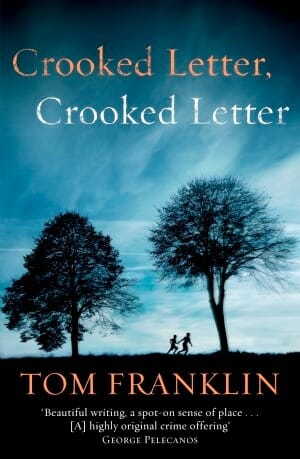Tom Franklin: Crooked Letter, Crooked Letter

The remarkable, painterly writer Susan Straight told me once that literary novelists are tiny rowboats next to the ocean liners of popular culture. “We’re rowing our leaky little skiffs like mad,” she said, “as we bail with a coffee can; and meanwhile there goes the giant Stephen King cruise ship or the James Patterson aircraft carrier, fully lit, the music playing, the passengers peering down at us from on high.”
So Tom Franklin just got a bigger boat.
Up until the latter part of the 20th century, literary fiction drove American book sales. Our great writers—Hemingway, Steinbeck, Faulkner, Cather, Fitzgerald—were the engines of enterprise for the New York publishing houses, and the groundbreakers for the culture, too. A new book by one of the big modern American literary lions meant that a cultural event had occurred, and sales followed.
Now, many of our literary writers have largely been relegated to the commercial backwaters, with just a few exceptions like Jonathan Franzen; and the genre writers have become the big ships. Stieg Larsson, ahoy. Thrillers, mysteries, science fiction, uh huh, even romances—those are the novels that now displace the most commercial and cultural water. Whether this means a wholesale dumbing-down of our culture or a welcome relief from navel-gazing, nothing-happens-twit-lit—well, you decide. But what has occurred means something very serious for those wretched scribes among us who face the keyboard and the blank page every day—it means that most writers who want to both keep writing and continue eating now feel the compulsion to pen a genre novel that can become a series that builds an audience and a brand.
It used to be shocking when a literary giant came down from the mountaintop and wrote genre fiction, but now it’s commonplace. In his last two books, Cormac McCarthy, one of our greatest living authors, wrote a mystery (No Country for Old Men) and an apocalyptic science fiction novel (The Road) that both sold quite well, were optioned and produced handsomely by Hollywood and allowed McCarthy to finally buy the house his many previous literary novels had failed to provide, thank you.
Tom Franklin may be embarking on the same path. Franklin’s first novels, Smonk and Hell at the Breech, came after a noteworthy string of beautifully-wrought short stories (Poachers) and drew a significant amount of praise from literary critics. Predictably, they sold in a very literary way, too. Sales were, as we say in the book business, modest. If a literary novel can sell 5,000 copies in a year, it’s considered a success today. But with the paltry royalties and advances now being paid for even the best literary novels, writers simply cannot live on the proceeds any longer. The normal way around this conundrum—teaching while writing—is the only answer for most literary authors.
And that, as you might suspect, is exactly what Tom Franklin has done. Franklin is a literature professor at Ole Miss in Oxford. But don’t let that deter you—he’s also a talented, terrific writer, mercifully free of the academic effluvia that often taints novels by professors. You won’t find effete existential subject matter or any tedious bouts of doubt and despair detailed in a Tom Franklin novel. Both Smonk and Hell at the Breech are beautifully-written, spare, atmospheric works of historical fiction. Smonk is hilarious and Hell is war, but both of these novels are tough-minded, literary and beautifully crafted works of art.
Hell at the Breech, based very loosely on the Mitcham’s Beat feud as it erupted into murderous retaliation and terror in Alabama in the 1890s (Franklin is a native of Alabama), describes the hard lives and the harder men that live them in the rural South more than a century ago. Some critics called Hell at the Breech the best American novel since Cold Mountain, even as they pigeonholed it in the Southern Gothic ghetto, but Hell at the Breech wasn’t just a great Southern novel, it’s a great American novel. It has that dark, deadly, compelling combination of a serious theme, a fully-realized place and time and a character-driven story about violence and violation that seem to be constants in all notable American fiction. And it has one other rare and powerful attribute—a believable and truly frightening antagonist.
-

-

-

-

-

-

-

-

-

-

-

-

-

-

-

-

-

-

-

-

-

-

-

-

-

-

-

-

-

-

-

-

-

-

-

-

-

-

-

-








































